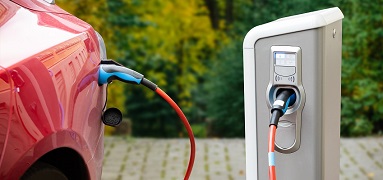NATIONAL REPORT—With more drivers switching to electric vehicles each year and the demand for EV charging stations increasing, more restaurant operators are exploring the possibility of installing them at their locations.
Subway and Domino’s are just two restaurant brands investing in this super-charged technology. Starbucks is another, having recently purchased 60 ChargePoint DC fast chargers for up to 15 locations along a 1,350-mile route from the Colorado Rockies to Seattle.

Investing in EV charging stations not only helps support sustainability goals, it’s also a potential driver of more customer traffic at the restaurants where they exist. Why? Drivers charging their vehicles would likely order food, beverages, and other merchandise while waiting for their cars to charge. With EVs typically taking at least half an hour to charge, drivers might stay longer and spend more money during the wait time.
As more electric vehicles take to the roads—it’s said EVs will make up 23 percent of new car sales by 2025—putting a charging station on premises is something customers could come to expect and, possibly, demand. Accommodating their needs, creating that seamless customer experience, would build brand support.
On the Road Again
Ann Arbor, Mich.-based Domino’s is rolling out 1,000 new Chevy Bolt electric vehicles at several franchise and corporate-owned stores nationwide, making it the largest electric pizza delivery fleet in the country. According to spokeswoman Danielle Bulger, most of the vehicles were purchased by company franchisees.
Bulger says the company sees a variety of benefits for using EVs, including cost efficiency, environmental sustainability, and workforce recruitment.
“The EVs not only help with hiring, but they also have zero tailpipe emissions and ample battery life, which potentially creates additional days of deliveries,” she says. “Maintenance costs are also lower than for nonelectric vehicles because they don’t require any oil changes. We believe our electric pizza delivery fleet is a great example of a brand action that works for the bottom line while positively impacting our planet.”
She notes that Domino’s, facing a delivery driver shortage, found applications for those positions increased upon purchasing the EVs.
“Our company always looks for inspired solutions to our biggest business issues, and one of those issues was a delivery driver shortage,” she says. “Over the past year, as gas prices rose, we not only faced delivery sales pressure, but also struggled to hire additional drivers across the U.S. That’s one of the big reasons we started using the EVs. The return so far has been positive, especially with hiring.”
Charging Oasis Sparks Interest
Quickservice sandwich chain Subway is banking on that as it partners with GenZ EV Solutions to create an “EV Charging Oasis of the Future.” The company’s goal is to offer added convenience for on-the-go guests, while helping protect the planet and create additional revenue for its franchisees.
The Subway Oasis charging parks are expected to create a smooth, integrated experience for EV drivers. They’ll consist of charging canopies with multiple ports, picnic tables, Wi-Fi, restrooms, green space, and even playgrounds at some locations. The parks, part of a multi-year plan, will begin rolling out this year as pilots at traditional and nontraditional sites and new or newly remodeled restaurants nationwide.
“We’re always exploring new ways to innovate and exceed our guests’ expectations for a high-quality, convenient experience,’ says Mike Kappitt, the brand’s Chief Operating and Insights officer. “This partnership with GenZ EV Solutions is a win for our guests, franchisees, and the planet. It will create dedicated spaces for drivers to charge their vehicles while they enjoy their food.”
Kappitt adds that the addition of the new charging stations will help communities build critical and necessary infrastructure.
To that end, the Biden Administration is encouraging the development of EV chargers throughout the U.S., with a near-term goal of installing 100,000 of them through public and private partnerships. Its 2021 bipartisan infrastructure legislation earmarked $7.5 billion for installing chargers.
In exchange for private-sector investments, the government is offering substantial tax incentives and credits to companies who buy EVs or install charging stations. The administration, by 2030, is seeking to reduce the number of gas-powered vehicles on the road to less than half of all cars sold in the U.S.
Sizeable Incentives Available
The Inflation Reduction Act created a “credit for qualified commercial clean vehicles” for businesses that buy an electric vehicle for commercial purposes. The new credit is worth up to $7,500 for passenger cars and smaller commercial vehicles, and up to $40,000 for bigger trucks. Business owners can get the credit for new vehicles purchased on or after January 1, 2023, and the credit is available for 10 years, through the end of 2032.
The Department of Transportation is disbursing $2.5 billion over the next five years, with $350 million going toward community fueling and charging grants, and another $350 million toward alternative fuel corridor grants. Additional funds are available to provide states with the tools to build the infrastructure.
“Restaurant operators should know that big tax credits on the federal and state levels exist,” says Aaron Frazier, the National Restaurant Association’s (NRA) Vice President of Public Policy. “They can support the purchase of electric vehicles and also provide some restaurants with a competitive advantage by lowering the vehicles’ purchase price along with long-term fuel costs.”
Article courtesy of NRA.






